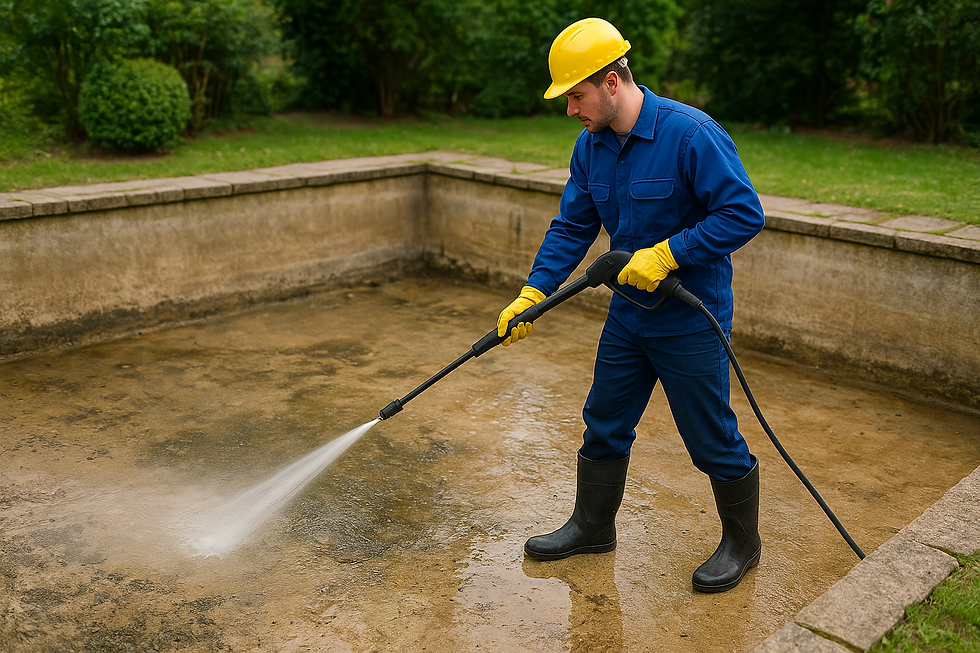Understanding and Improving Water Quality in Water Features
- Ken Wu
- Oct 1
- 3 min read
A beautifully designed water feature brings movement, sound, and tranquility to any space — but poor water quality can quickly turn it from a focal point into an eyesore. Cloudy water, unpleasant odors, or algae buildup are all signs that something is off. Let’s explore the common reasons for poor water quality and the best ways to improve it.
Common Causes of Poor Water Quality
1. Lack of Circulation
Water that doesn’t move becomes stagnant. Without proper circulation, debris settles at the bottom, algae grows faster, and oxygen levels drop — all leading to murky, unhealthy water. Circulation is especially important in large or irregularly shaped ponds and fountains where “dead zones” of still water can form.
2. Garbage, Leaf Debris, and Animal Waste
Organic matter like leaves, twigs, garbage, and bird droppings quickly degrade water quality. As this material breaks down, it releases nutrients that promote algae growth and produce foul odors. Regular cleaning and skimming are essential, especially in outdoor features surrounded by trees or frequented by wildlife.
3. Ineffective or Dirty Filtration System
A water feature’s filter is its main defense against contamination. Over time, filters can become clogged with debris and biofilm, drastically reducing their efficiency. Inadequate filtration systems or poorly maintained filters often lead to cloudy or greenish water.
4. Imbalanced Water Chemistry
Unbalanced chlorine or pH levels cause multiple problems — from algae blooms to corroded equipment. pH that’s too high (alkaline) reduces chlorine’s effectiveness, while pH that’s too low (acidic) can damage pumps, seals, and surfaces. Keeping water chemistry balanced is key to a clean, safe system.
5. Infrequent Maintenance
Even the best-designed systems degrade without consistent care. Neglecting routine cleaning, chemical checks, and inspections often leads to long-term damage, expensive repairs, and persistent water issues.
Ways to Improve Water Quality
1. Clean Filters and Add Chemicals Rguarly
Rinse and clean the filters frequently to remove trapped debris and biofilm. Depending on the system, adding the appropriate chemicals — such as chlorine tablets or algaecide — can help maintain clear water and control bacteria.
2. Drain and Deep Clean the Fountain
For persistent problems, it’s best to drain the entire system and thoroughly clean the basin, pumps, and piping. Pressure washing and scrubbing off algae or mineral buildup will reset the system and restore visual appeal.
3. Check and Adjust Chlorine and pH Levls
Regularly test the water to ensure chlorine levels are within the recommended range (typically 1.0–3.0 ppm) and pH stays between 7.2 and 7.8.
Low chlorine → leads to algae and bacterial growth.
High chlorine → may corrode metal parts or irritate skin if the feature is interactive.
Incorrect pH → reduces sanitizer effectiveness and causes scaling or staining.Maintaining balance ensures water stays clear and safe while protecting equipment.
4. Improve Water Movement
Enhancing water circulation is one of the best ways to improve water quality. This can include:
Upgrading to a larger pump or adjusting flow rates.
Installing water jets, aerators, or bubblers to promote oxygenation.
Manually stirring stagnant areas in smaller features to encourage movement.
5 RegularSkimmng and Debris Removal
Dedicate efforts to remove leaves, twigs, and garbage before they sink to the bottom. A few minutes of surface cleaning each week can prevent hours of deep maintenance later.
Final Thoughts
Good water quality doesn’t happen by chance — it’s the result of consistent care, balanced chemistry, and proper system design. Whether your water feature is a small garden fountain or a large architectural pond, regular maintenance and proactive checks will keep it clean, clear, and inviting all year round.




Comments